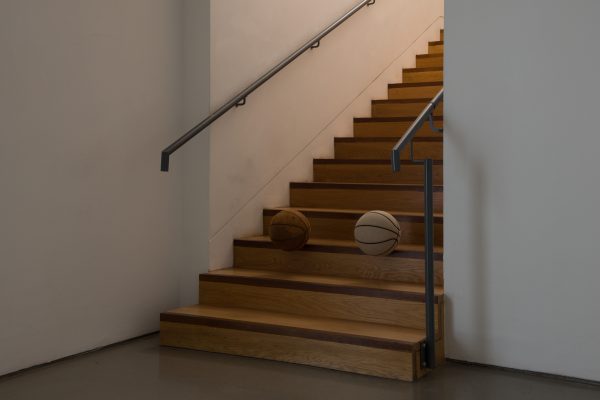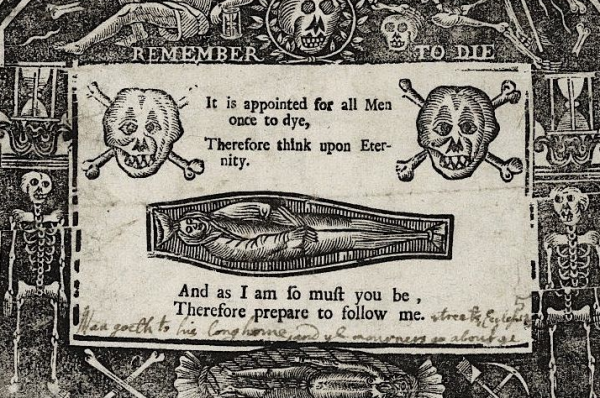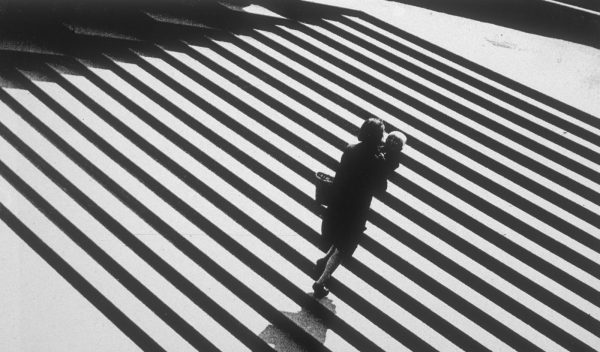Don’t you ever want the kind of family where you’re just allowed to be…
My brother trails off, his sad blue eyes etched with lines. There are 13 years between us, and it’s been 5 since we last met. We’re having brunch opposite the Henry Moore Institute. The empty restaurant is decorated with imitation sweet peas, a garish canopy of purple and white plastic droops above our heads. He’s insistent I eat and determined to pay.
He took care of us, my sister and me. He took care of everyone, even our other brother, the eldest, loudest, favourite. We never called them our half-brothers, because why describe the family you saw the most as anything less than whole.
He gave me my first Hooch. First listen to Jagged Little Pill, hedgerows clawing at our headlights, driving fast down dark country lanes. He taught me how to shape the visor on a baseball cap, how to banter. I learned about my desire by observing his. Furtive looking from the back seat or barstool. Standing in the bathroom at a house party, trying not to watch as his girlfriend has a wee. Her glossy brown hair smelt of coconuts, stone-wash denim bunched around her thighs. Heartbroken when they ended.
My brothers. They had done everything and got away with it. My mother: terrified.
Approaching the barrier at Leeds station, an image of him materialises. Twenty-three years ago, a young man waiting for us on the other side. That’s what physical places can do: time travel. Today, I’ve arranged to meet him because he’s been absent. The proper term is estranged. No blowout or cross words, just a slow disappearance, like a newspaper clipping gently fading in the sun.
From our brothers my sister and I learnt the art of keeping secrets. We did not speak of our experiences, of difficulty or pain. We disconnected. Silence was easier. Which is to say, our mother couldn’t cope with who we wanted to be.
It would crush her.
Our combined longing fills the whole restaurant. What we lacked as children, he has sought to grow. The good life. His family are seedlings, kept separate, protected under glass.
The four of us, we’re dysfunctional.
I flinch at the implication that my choices (or lack of) might be evidence of some ‘abnormality’. We part ways here, his attachments repelling mine. Our needs, rooted in the same place, sprouting in opposite directions.
Perhaps the family is the ultimate found object. Something ubiquitous, recognisable, reproducible, destructive.
*
Like my brother, the American artist Michael E. Smith is a dad. This seems relevant in ways it never has done before. Perhaps because, despite Smith’s previous use of household items – children’s pyjamas, sofas, bathtubs – there are almost no references to family life in the discourse surrounding his practice. This omission troubles me, and as I digest his new exhibition at the Henry Moore Institute, it feels increasingly untenable.
The familial begins with the gallery itself. You enter the building through a shiny façade of black granite fixed to the gable end of three nineteenth-century terraces. Glass doors open seamlessly in response to presence but not touch. The once domestic character of these spaces has now been erased. Not erased, actually, but consumed, the original architecture metabolised.
Hot. The reception is hot. It’s the kind of heat generated by infrastructure of a particular scale: department stores, care homes, leisure centres. Immediately, I’m suspicious. Has he turned the temperature up?
This is not my first rodeo. Smith’s installations often incorporate environmental tweaks, atmospheric interventions that challenge expectations of the exhibition’s beginning or end. The first work listed in the handout – a camera feed of a dog in a kennel – is shown on a monitor above the reception desk. This looping footage, a two minute and seven second segment shot from above, sets a paranoid tone. Hyper presence meets psychological absence; your faithful friend might be safe, but they’re stuck in a cage. I search the image and eventually the animal’s curled immobile body reveals itself, almost indistinct from bundles of fabric, wadding and foam.
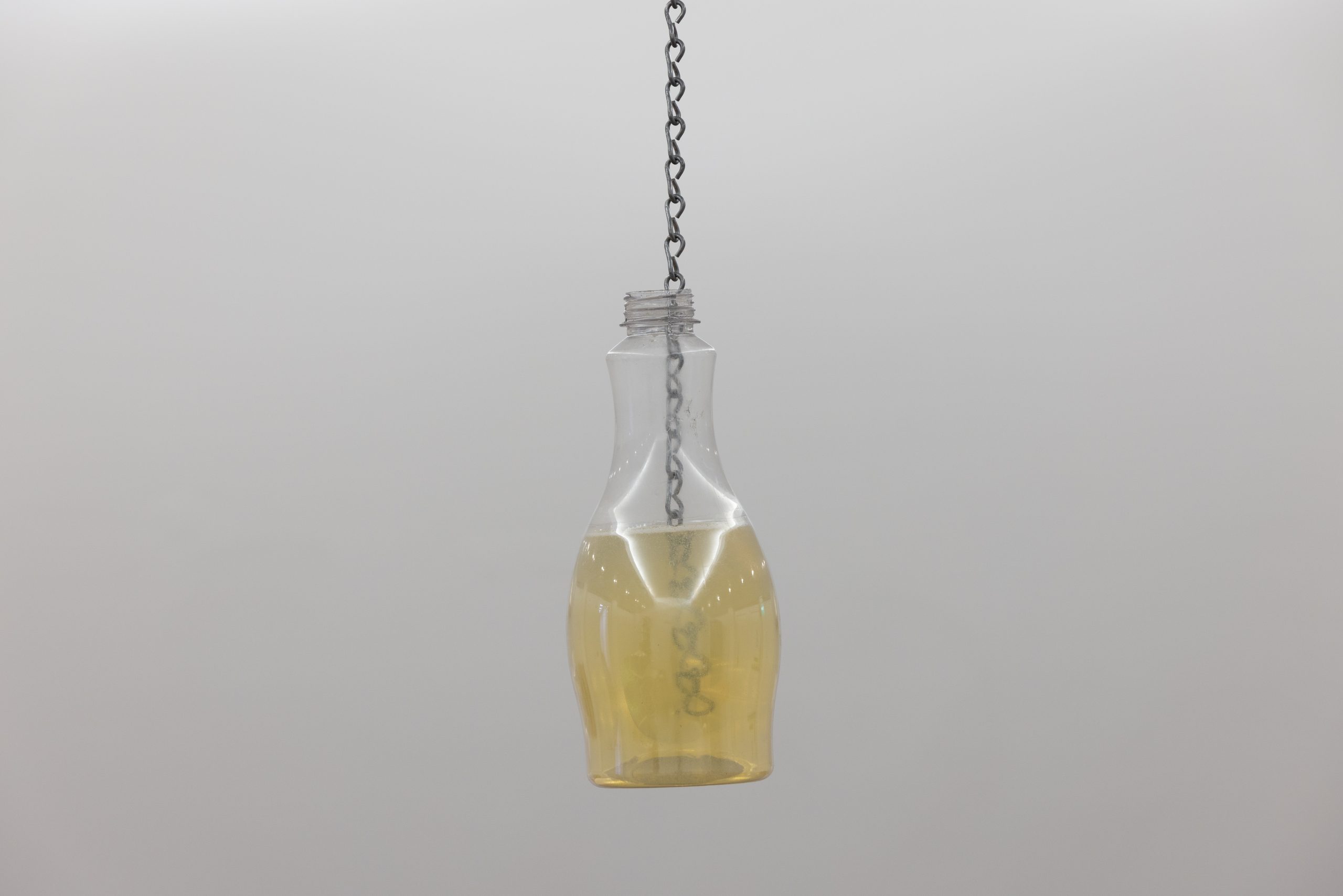
It’s been eight years since I experienced one of Smith’s installations. Amsterdam, 2015. Back then I wrote about the show’s lack of lighting, the artist’s activation of atmosphere as both a material and conceptual tool. I was interested in the reductive rather than additive processes Smith enacted on his objects, but also the gallery architecture. These removal strategies, I argued, provoke us to pay attention differently, while resisting the clarity and productivity demanded by dominant cultural forces to ensure smooth and easy consumption.
These strategies persist in Smith’s new exhibition. All the lights within the three galleries have been switched off and a series of found objects have been selected, treated and sparsely arranged. Although Smith continues to practice the same methods, the atmosphere they produce has changed. Gone are the meat slicers, nail guns or pallet jacks, objects with the potential to cut, puncture and cause pain. In their place are items of leisure and entertainment: a television, armchair, two basketballs. What was industrial is now domestic. Despite their homeliness, the threat of Smith’s installations hasn’t deescalated. It’s just that their target has shifted, turned inward.
*
The light in this first gallery is crepuscular, the thinking man’s term for when deer get killed. A crack escapes from closed shutters, illuminating the edge of a flat screen television lying face down at my feet. Against its top right-hand corner is a lozenge shaped rock. I get down on my knees for a closer look, palms cooling as they press to the floor. The tip of the rock and the machine’s plastic bezel are perfectly aligned, floating equidistant above the ground. These formal details feel important, as though revealing how intimately Smith knows his materials. The artist complies with Richard Wollheim’s 1965 definition of Minimal Art by attending to the bare essential facts of the objects. And yet, unlike the minimalist practices of Smith’s forebears, in which, as Kyle Chayka observes in his book The Longing for Less: Living with Minimalism (2020), ‘sensation replaced interpretation’, these works court narrative.
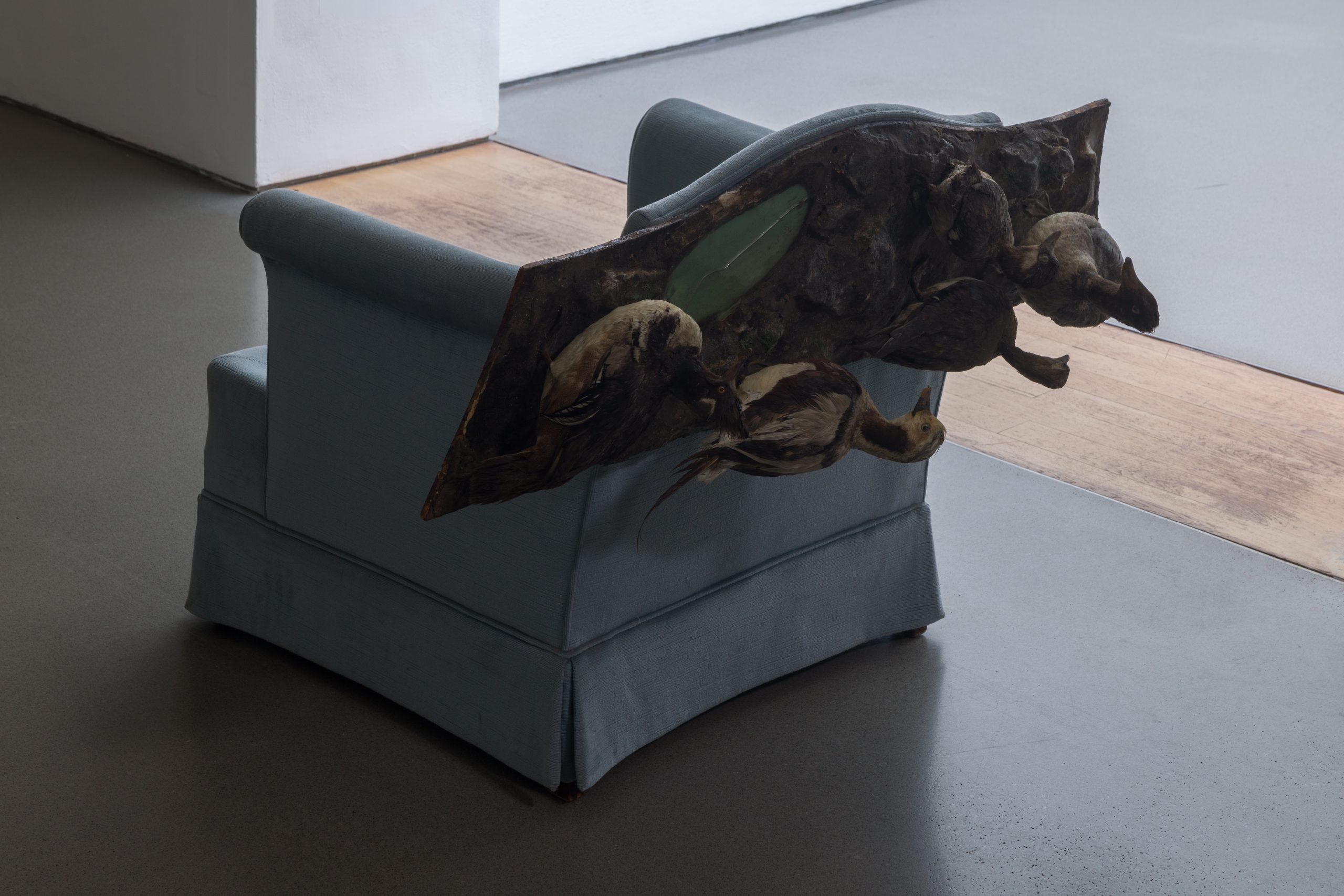
Deconstructed living room. Has rock smashed screen? An accident reorganised, the only witness: a tatty armchair upholstered in baby blue chenille. Sutured to the chair’s back is a dusty wooden panel with a diorama of taxidermy ducks. At the base is a valence, a kind of modesty skirt, something to make it look smarter and nicer, something to conceal. A lonely old man’s favourite spot to watch the telly. A hunter. Raymond Carver and the Great Lakes. The chair’s cushions have been removed. Objects intended to provide comfort are turned hostile. I think of the cotton squares used by the Stasi in post-war Berlin to absorb a suspect’s scent. Hidden under seat cushions and removed after interrogation, these fragrant rags were then sealed in airtight jars for later use by sniffer dogs. ‘Does it make you feel like something has gone wrong?’ A man’s voice travels across the gallery, breaking my train of thought. He’s speaking to a young boy wearing a red baseball cap. They stand together silently, looking down at the television screen. The boy shifts nervously from foot to foot.
Rather than add up to meaning, these free associations float around the exhibition, each contact shifting the rhythm of my experience, modulating like the free jazz that Laurence Sillars, Head of Henry Moore Institute, tells me Smith listened to while installing. It took him only five days to assemble, and he didn’t visit in person beforehand. Somehow, I’d thought his site-specific practice might need more physical presence. The installation’s elements were flown on a single pallet from his studio. Prior to their arrival, Smith refers to these objects as ‘material sketches’; they only become artworks when combined with the gallery environment. Sillars explains that Smith’s first questions were about the building and how it was used, ‘the main traffic routes, blockages, interruptions, where people congregate, all those hiccup moments.’ Working from photographs and floorplans, he was shocked by the number of spotlights. ‘What’s going on with your ceiling?’, he queried.
In the spirit of institutional critique and the ‘dislocations’ of artists such as Michael Asher, having deactivated the lights in the gallery, Smith attended to the fire exit fixtures usually hidden from view. Blue gels were added to escape routes to complement the central gallery’s daylight, drawing attention to functional spaces usually deemed of little aesthetic interest. In the final gallery, the industrial-goods lift is revealed, a dark metal cube which gapes like an open mouth. As with the objects Smith decommissions to become artworks, the lift is out of action.
Unfulfilled potential permeates this exhibition. The gallery’s walls can support up to 100 kg/m, its floor 10 tonnes per single sculpture, and the concealed glazed doors allow access for works almost 7 metres high. I like how Smith refuses to engage with these inherited attributes, as if taunting previous generations of artists who have exhibited here. I’m thinking of Sol LeWitt’s Cinder Block Piece, a towering sculpture of concrete which filled the gallery in 1993, or James Lee Byars three metre wide gilded bronze sphere The Monument to Language, shown three years later. It’s funny how posturing and excessive these architectural works seem in the face of an affective experience consisting of practically nothing. As Robert Smithson remarked to Allan Kaprow in 1967, ‘Installations should empty rooms, not fill them.’
*
‘Does it smell like death to you?,’ the invigilators ask one another, as they huddle around the chair partly made of taxidermy ducks. I breathe deeply through my nose, but all I can detect is the faint lemony fragrance of floor cleaner and the earthy scent of fresh emulsion. This object faces off with a pair of basketballs miraculously balancing on a stairwell leading to an inaccessible upstairs gallery. Unlike Jeff Koons’ floating Spaldings, Smith’s basketballs are unbranded and they’ve been brought down to earth. One is marked with oily stains, its textured rubber smooth from repeated use, the other is white. At first I assume the soft fuzz is a fabric. I’m no expert in basketballs and besides, like the invigilators, I’m too preoccupied with how he’s managed to the fix the balls in place. I hear them speculate – ‘If they’re cut, how do they maintain their shape? Bolted, screwed, wedged? Filled with expanding foam?’ Then it hits me. He’s peeled off the leather; the ball has been skinned.
I sit in a darkened corner of the third gallery. The ceiling’s silver gills circulate air, a light breeze on my face. In the quiet hum of the ventilation system, I hear the blood pumping around my head. From this position I get a good view of the vast lung that is the second gallery. Two nine-metre skylights run like seams down the sides of this double height space. Nothing physical touches the terrazzo floor, but the spectral outlines of plinths or previously exhibited sculptures are visible in the surface of the resin-bound aggregate. Aside from these geometric stains, the skylights’ rectangular shapes pattern the reflective floor in pleasing lines. These traces feel part of the work. In this room, Smith has chosen not to close the mechanised blinds and the light lifts the spirits. Meanwhile, the two gloomy spaces flanking this central chamber secrete an ominous sort of dread. The implication: darkness is a phase you have to pass through.
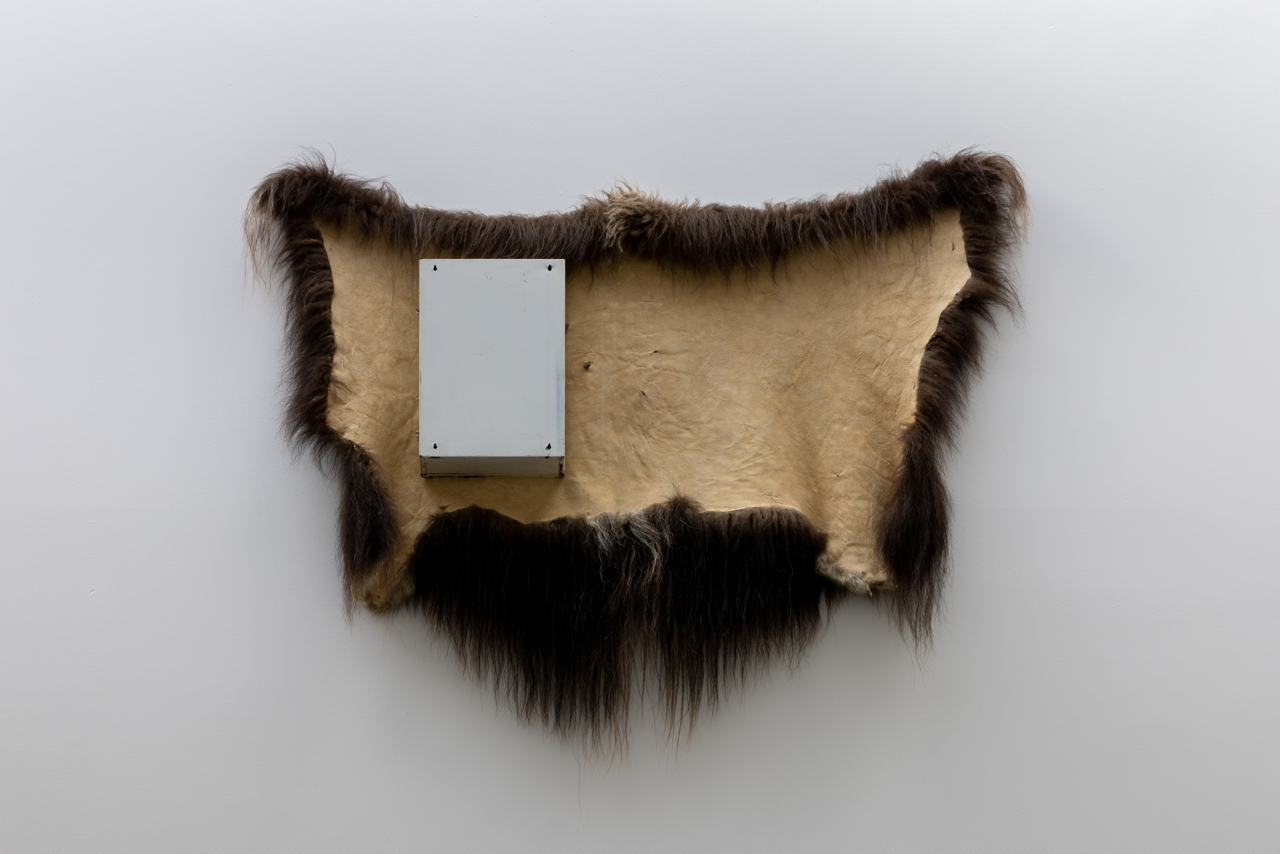
A crack of white outlines seven-metre-high glazed double doors beyond one wall. Either side of this strip of light, positioned symmetrically above my head, is a DVD player and VCR. These black machines are of similar size and shape, forebearer and heir in a shared history of home entertainment. The work’s title – the only one not Untitled – is BUGS (2023). Like the cartoon eyes of America’s favourite cheeky rabbit, they stare back blanky from the expanse of an otherwise empty wall. Across the room, a shaggy animal hide – bear? buffalo? – is pinned skin side up to another wall, limbs flayed, pressed flat by a grey, battered first-aid cabinet.
Many of the objects are presented in unfamiliar orientations, revealing angles not usually shown to the world: the back, bottom, underbelly. In the third gallery, two circular white tables, one belonging to Smith, the other to his assistant, Jesse, are placed on top of one another so their surfaces ‘kiss’. This table totem has a formal simplicity from which Smith clearly derives pleasure. Balanced on the top of the flipped table base is a plastic milk jug glowing red with LED lights. At a distance it sort of looks like a fountain. In Smith’s pairs I see familial arrangements. Parents, siblings. The couple, two by two.
*
The figure of the child haunts this show. There are the handprints of Smith’s actual children visible on the surfaces of a table base, and the child as a symbol of future potential, conjured by Sillars in the first lines of the handout. The text describes a school bus depot overlooked by Smith’s studio in Providence. From his large windows, the artist observes rows of glossy yellow vehicles, reflecting on these as stand-ins for the kids that ride them, vessels holding ‘the ghosts of these lives’. I think of Svetlana Boym’s book The Future of Nostalgia (2001), and her description of that which ‘appears to be a longing for a place but is actually a yearning for a different time – the time of our childhood, the slower rhythms of our dreams.’
Sillars tells me Smith refers to his practice as ‘drawing ghosts’. In this sense, it feels like he might be mourning. But what? His children’s youth? A sustainable future? America? Mary Gaitskill’s haunting description of musician Karen Carpenter in her novel Veronica (2008) comes to mind. Something about the combination of sickly soft-rock Americana and tragic death resonates: ‘When she shut herself up in her closet and starved herself to death, people were shocked. But starvation was in her voice all along. That was the poignancy of it. A sweet voice locked in a dark place but focused entirely on the tiny strip of light coming under the door.’ In Smith’s ascetic installations, the sentimentality of school buses and milk jugs are similarly trapped, waiting in the darkness with the shutters closed.
Smith’s objects are dredged from his own youth, ‘the iconography of 80s mundanity’, to borrow a phrase from Grafton Tanner, author of The Hours Have Lost Their Clock: The Politics of Nostalgia (2021). Tanner argues contemporary digital society is haunted by the analogue past, citing programmes like Stranger Things (2016 -) which revel in dated televisions, furniture and fashion. Speaking with journalist Paris Marx in a 2021 episode of the podcast Tech Won’t Save Us, Tanner laments the perpetual rebooting of past characters and worlds by franchises like Disney or Marvel. ‘Old ideas need to die out, they just do.’
The family, entropy, objecthood; are these the kind of old ideas that need to die out too? As someone who is drawn to minimalism, its languages and legacies, I’m comforted by Smith’s installations. There’s a nostalgia to them that’s not dissimilar to the feeling of being soothed by a dated but familiar TV show. And yet, good reboots activate old characters, filling them with new life. Viewing Smith’s installations is like contemplating recent history on the slab, dissecting the corpse.
*
As the train departs Leeds, passing through the roofless, crumbling warehouses of Derby and the oily brown canals of Birmingham, I text my brother with apologies, ashamed by how quickly our meeting had turned to certain family matters, emotions simmering under the surface of our words. When you learn not to speak about things, direct questions reveal unmet needs. Because to ask, ‘why did you leave?’ is really to say, ‘will you come back?’ My brother responds with reassurance. We play our roles like old times, making promises we can’t keep. The months will pass, he’ll have playdates and parties, extracurricular activities, as the merry-go-round of the nuclear family keeps turning.
Excluded from this scene and reeling from the sudden proximity to my brother, I had walked away into an installation filled with the remnants of family life, of everyday household consumption and animal destruction. Feelings from our encounter were carried into the gallery like smoke clinging to my clothes. At first, I found solace in Smith’s domestic wasteland, it reflected my mood. His artefacts appeared dystopian, coldly familiar, as though the home they were pulled from was anything but sweet. Less freshly baked cookies, more sour curdled milk. Absent parents out hunting and stoned kids watching TV. But the longer I stayed in the gallery, the more Smith’s dredging of family life felt sentimental, as if holding onto something too tightly. Was I standing in a shrine? By choosing to pick over the scraps of this institution of intimacy, Smith seems unable to detach himself from it. Perhaps parenthood increases your fascination with entropy; you reproduce so you might continue, and yet, watching your children’s growth is to be faced with your own decline.
The handout describes Smith as examining his chosen materials with ‘an engineer’s mindset’. The engineer is a figure who designs and evaluates, but also maintains. Despite the affective powers of the installation, its quiet threat, Smith’s labour enacts a form of maintenance that never allows me to escape the ideological baggage of his objects. And while he may wish to remain shut up in the closet, focused entirely on the tiny strip of light coming under the door, I want out of the dark.
